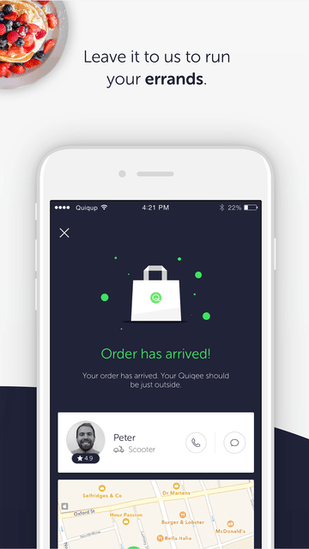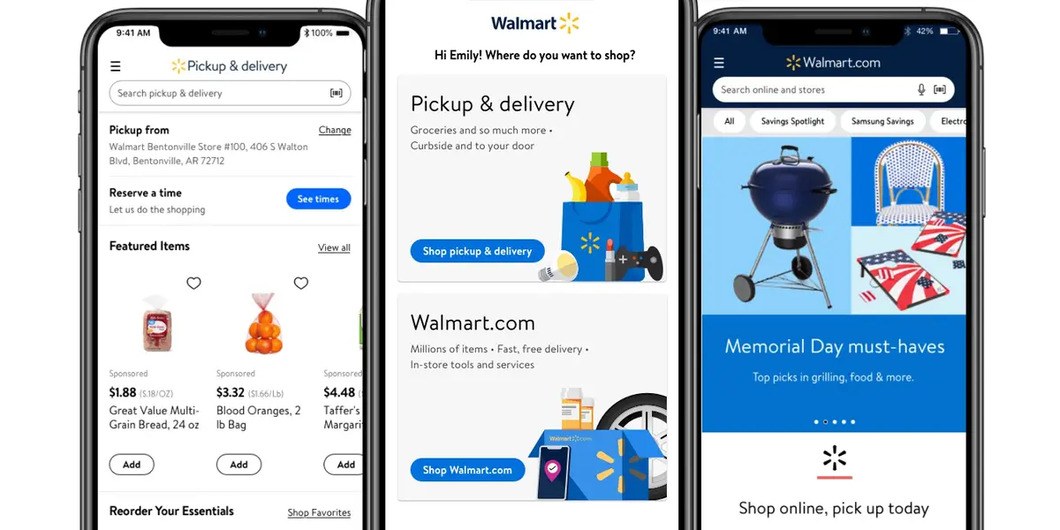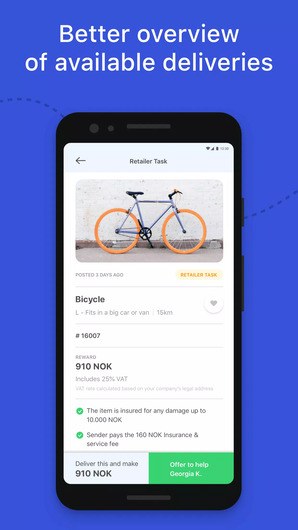The article was updated on June 18, 2023.
For over a decade, the on-demand economy has been gaining popularity among consumers all over the world. Pioneered by Uber, Postmates, and AirBnB, it is currently one of the most widely used business models, disrupting businesses and redefining customer experiences across a number of industries. Also, with the spread of Coronavirus worldwide (COVID-19), the need for on-demand services has increased.
Today, consumers use on-demand delivery to get anything you can imagine, whether it is groceries for their dinner, flowers for loved ones, or even furniture for a new home. With that said, an on-demand delivery service can take nearly any business to a new level. But even when considering only one delivery type, namely food delivery, we can see its market volume skyrocketing, as it is expected to reach $466 billion by 2027.
In this article we will highlight the benefits, use cases and features of on-demand delivery apps. So, if you want to join the trend and adopt the on-demand delivery model for your business, then here are some things to consider.
What is an on-demand delivery app and how does it work?
On-demand delivery apps allow customers to order desirable products whenever and wherever they want. Basically, within one app, users shop for the goods they want to purchase and arrange for them to be delivered, all in just a couple of minutes. It’s arguably the most convenient and flexible online shopping option.
So, how does on-demand delivery work in practice?
On-demand delivery services represent instant and well-coordinated communication between a customer, a seller, and a delivery company. The buyer orders a chosen product and the store delegates its delivery to a dedicated service. The customer often has free reign of choosing the timespan and the destination point of delivery. Clients can also track the package throughout the journey and keep in touch with the courier.
Knowing how on-demand delivery works, it’s easy to understand how many benefits this kind of service can bring to the customers of a business. Let’s take a closer look at why people use on-demand delivery.
What are the main benefits of on-demand delivery apps?
The main function of any on-demand app is to match demand and supply in the fastest way possible. This is especially true when applied to on-demand delivery services: It prioritizes speed and convenience above all.
In addition to that, on-demand delivery offers a number of benefits for both businesses and customers. Namely, on-demand services include the following aspects:
Fast
It usually takes from 10 minutes to 24 hours to execute an order, depending on the type of service. Yet, the order placement takes just a few taps, so the process is easy and convenient for both the customer and the provider.
Cheap
The on-demand model relies mostly on independent contractors using their own form of transportation. That is why a business owner doesn’t need to hire full-time couriers or take care of their logistics, unlike traditional delivery providers. Plus, 80% of the people using on-demand apps report being able to save money on delivery.
Convenient
From placing an order to making a payment or tracking the order in real time, on-demand delivery apps are made to be convenient and easy to use. From a business point of view, this allows you to set up a streamlined and efficient process by removing the additional layer of micro-management and connecting customers directly to couriers.
Transparent
Mutual ratings and feedback provided by the customers and couriers allows for better visibility and trust-building. Moreover, as a business owner, you can monitor the feedback and address the issues as soon as they arise (even if a customer didn’t file a complaint).
Mobile-first user experience
One of the main characteristic features of an Uber-like app, including the on-demand delivery, is that it relies primarily on a mobile-first user experience. Unlike web-based applications, mobile apps offer greater flexibility and allow users (both the customers and couriers) to request or provide services on the go.

Types of on-demand delivery apps
If you want to learn how to start an on-demand delivery business, it’s better to start from the two main on-demand delivery app types. They differ in structure and functionality, yet, they both can be advantageous for you and your customers. Read on to choose the one that suits your business model.
Aggregators/marketplaces
If you’ve built a brand-new business, or just don’t have a large customer base, you don’t need to create an on-demand delivery app for your company and invest your money in it. Rather, you can join a community of related stores that offer their products in a marketplace for an on-demand delivery app.
Just like in the case of food delivery apps like UberEATS, Foodpanda, or Instacart, users can choose meals and products from several restaurants, compare prices, and find the best option for them. For businesses, it’s a great way to go out into the world and become visible to potential clients.
A dedicated app for a specific business model
Almost any company that sells its goods can launch its delivery on-demand service. With a custom delivery app, a business from any niche can gain a huge competitive advantage and grow faster and more efficiently.
That’s why such industry leaders as the pizza giant Domino’s Pizza with its AnyWare delivery service, or the age-old Walgreens company with its own on-demand pharmacy delivery app are so widely known. But to reach that high, you need to learn how to make an on-demand delivery app of high quality or find a trustworthy team of professional app developers.
Regardless of the chosen approach, offering a fast and convenient delivery service is a powerful competitive benefit that can set you apart from your competition in a certain niche. The following examples of successful on-demand delivery apps further prove this point.
On-demand delivery use cases and examples
On demand delivery is getting widely adopted in very different verticals and businesses. The Uber business model can be applied to almost any niche:
1. Courier services
This means peer to peer delivery services, where you request a courier to pick up your stuff at one location and bring it to another one. This approach is popular with services like parcel delivery, laundry (e.g. Rinse), etc.
Some courier services can become long-time delivery partners for eCommerce stores or warehouse owners, thus stepping up their selling performance and bettering their customer experience (e.g. Quiqup).

2. Fuel delivery
On-demand fuel delivery is relevant for people who can’t or don’t want to go to gas stations to get their vehicles fueled. These services, like Fuelster, transport gas to their customers and refill their tanks, no matter where they are. It’s a life-saving kind of service for busy car owners, who want to refill their cars fast, safely, and cost-efficiently.
3. Grocery delivery services
In the last years, grocery customers have become used to buying products and having them delivered without leaving their homes.
That is why an on-demand grocery delivery app can be a successful and profitable project, especially when following the examples of such leaders as Walmart. Such deliveries often offer membership subscription plans, when you pay once for free unlimited delivery during a given time span.

4. Flower delivery
People use on-demand flower delivery services like 1800Flowers to order a unique bouquet made of fresh or dried flowers as a gift. Such services offer season- or event-related flower compositions and can deliver them to a given destination from a local store on the same day, or to different cities and countries when ordered beforehand.
5. Food delivery
On-demand food delivery apps like Grubhub or UberEATS. The segment is one of the most crowded, yet very profitable. These on-demand delivery services deliver restaurant food and groceries with the help of their own delivery people, enabling us to have our favorite meal at our doorsteps with a matter of a few clicks.
Postmates, one of the first and most popular on-demand delivery services has started as a courier/goods delivery business. Yet, the company recently pivoted to focus mostly on food delivery.

6. Pharmacy delivery
An on-demand pharmacy delivery app works differently from other kinds of delivery services. Many of them, e.g. NowRX, don’t charge additional fees from their customers. They deliver medications and other healthcare products for free, and clients pay only with their regular insurance.
7. Moving and furniture delivery
This includes on-demand truck and hauling services (Lugg or Dolly). You just set your pickup location and destination, choose the size of vehicle that is right for you, and the preferred arrival time. Once the order is picked up, you can message helpers in-app, and track your items along the way.
8. Peer to peer delivery marketplaces
These apps allow you to post a delivery request and get connected with a person traveling in the desired direction (e.g. Nimber, Roadie, or Grabr). These marketplaces are less regulated and tend to focus on international deliveries, rather than local.

As you can see, whatever niche you’re engaged in, a well-designed on-demand delivery service can always find its application in your business plan and make you a successful player in the market.
Regardless of the specific model or segment these apps target, they share common business logic and a number of key elements. So, here are the must-have features of an on-demand delivery app.
How to build an on-demand delivery app? Core features and capabilities
Similar to any on-demand economy app, it takes 3 different products to build an efficient delivery system. These include a customer-facing mobile app, an app for couriers, and a web dashboard for the administration.
Customer app features
- Login/Authentication. Most apps use social networks, email, or a phone number to authenticate their users.
- Orders. This includes the ability to place an order in app or add orders manually. The basic information includes addresses (pick-up and drop-off locations), customer’s info, product info, price, and preferred delivery time (if applicable).
- Matching algorithm. The ability to match the order with the closest free courier, based on location or current route.
- GPS order tracking. The ability to track the current location of your package and the time of arrival using location services is the core feature of any on-demand delivery app.
- In-app messaging or integration with phone calls is needed to re-schedule the delivery or contact the driver after the order has been accepted.
- Payments. Possible options include card payments, integration of mobile payment gateways (Stripe, Braintree, Paypal), hardware integration (Square), NFC payments (Apple Pay, etc.).
- Rating system. The ability to rate the courier and leave feedback.
- Personal profile, including order history, rating, preset personal info (name and addresses), and payment details.
- Push notifications for cases when the order is on the way or has arrived. This serves as an addition layer of customer experience and can be a powerful engagement tool.
- Additional features – Loyalty and gamification features such as points, discounts, coupons, and invites.
Courier app functionality
Unlike the customers, contractors will need an additional level of security. Thus, the courier profiles should be created by the company management only for verified couriers. Alternatively, a verification process can be implemented through the couriers’ on-boarding platform.
- Order details. The ability to review available orders, view an order and the client’s details, and accept the most suitable ones.
- Booking the order. It allows couriers to bid for orders.
- In-app messaging for communication with the client.
- Delivery status. A delivery man can update the customer when he has accepted/rejected the order, picked it up and delivered.
- GPS navigation for in-app navigation.
- Ratings and feedback. For complete transparency, not only the customers, but the couriers should also be able to rate their clients and leave feedback about the order.
- Personal profile that includes basic data about completed orders, earnings, etc.
- Additionally, you can add an ability for couriers to accept tips from their clients.
Web-based management portal
- Customer and courier profiles database plus, partnering businesses profiles, if applicable.
- Customer support module (e.g. real-time chat or email integration).
- Accounting module (transactions and payment details).
- Advanced analytics detailing the customer’s/courier’s activities, placed and completed orders, etc.
How to monetize an on-demand delivery app?
On-demand delivery app development pays off handsomely, once you launch an appropriate monetization model. There are plenty of strategies you can choose, ranging from general to specific.
Let’s see how you can build an on-demand delivery app that brings revenue to your business.
1. Delivery charge
This strategy is the most common way to ensure a stable flow of income for delivery on demand. From each order, the delivery service charges a predetermined flat fee or a non-fixed percentage. The latter can be based on a meal price in the case of food delivery, or selected order details, such as weight, distance, package type, etc.
2. Peak time delivery
If your delivery is connected to the time of the day, you can make an extra buck on it. That is, many delivery services raise the prices for delivering orders during peak times. Another tactic is to block delivery in certain regions during busy hours and allow unlocking it for an additional payment.
However, it may be not as effective as simply increasing the price, as your customers may want to find another service that allows delivery at any time.
3. Commission from merchants
Having a high-quality on-demand delivery service is a strong competitive edge for any shop or restaurant. It brings them additional revenue and improves their reputation, and you may fairly want to share their profit.
You can offer long-term cooperation with merchants on a commission basis, so they will pay you a percentage from each order you deliver to their clients.
4. Selling an API
Another way of cooperation with stores and restaurants is to offer them your delivery platform in the form of an API. Then, they implement your on-demand delivery service on their website or app, and their customers will have an option to choose your service when they order a product.
5. In-app paid features
Having additional valuable features for fair extra prices is a great way to make money on your delivery application.
For instance, for an additional fee, you can offer customers the ability to prioritize their order for fast delivery, get access to unique sales, choose special packaging, etc. In this context, the freemium model has proven to be the most effective one.
6. Advertising
In-app banners and other kinds of ads are a classical marketing and monetization strategy that also works great for on-demand delivery apps. Consider allowing businesses from related niches to promote their products or services to your customers in the app.
However, to avoid giving your brand a bad rap, make sure you check the reputation of the restaurant or shop you advertise.

How to enter the on-demand delivery market and win over potential users?
While the on-demand delivery market is pretty versatile and includes a number of use cases, there are certain strategies that you should take into account.
So, if you want to build an on-demand delivery app for your business, consider the following advice:
- Launch locally. It is easy to set up and manage the delivery process within a single location and later expand to more cities.
- Promote your app early. This will help you attract early adopters and beta-testers, as well as get noticed by potential investors.
- Start with an MVP. Just like a local product launch, building the first version of an app with limited functionality is a good way to test your product with minimum investment and to easily pivot if needed.
- Offer on-the-spot support and fast issue resolution. Your customers should be able to get help instantly, otherwise this can lead to dire consequences (which is especially dangerous for a startup or a small business).
- Set up a contractor selection process and conduct regular screening to prevent stealing or poor service.
- Introduce loyalty programs to engage and retain your users.
But above all you will need a reliable and skilled software development partner. We at Eastern Peak specialize in building on-demand economy apps, and have built very successful products in the transportation, repair services, and automotive segments.
View our portfolio of Uber-like apps.
How to get started?
The product discovery phase is the best first step you can take to lay a solid foundation for your on-demand delivery app development. It includes a functional specification, UX/UI design, and a visual prototype that will give you a clear vision of the end product. On average, this phase takes 4-6 weeks.
The product discovery phase can help you:
- define a full scope of work and develop a roadmap for the project
- set a realistic budget for your MVP and plan your resources
- test the waters with your audience using a visual prototype
- craft a convincing investment pitch
- get to know your team
Based on our vast experience building Uber-like apps, we have come to understand what it takes to build a successful on-demand product. Contact us now to discuss your on-demand app idea, or the opportunities of this model for your business.
Read also:


